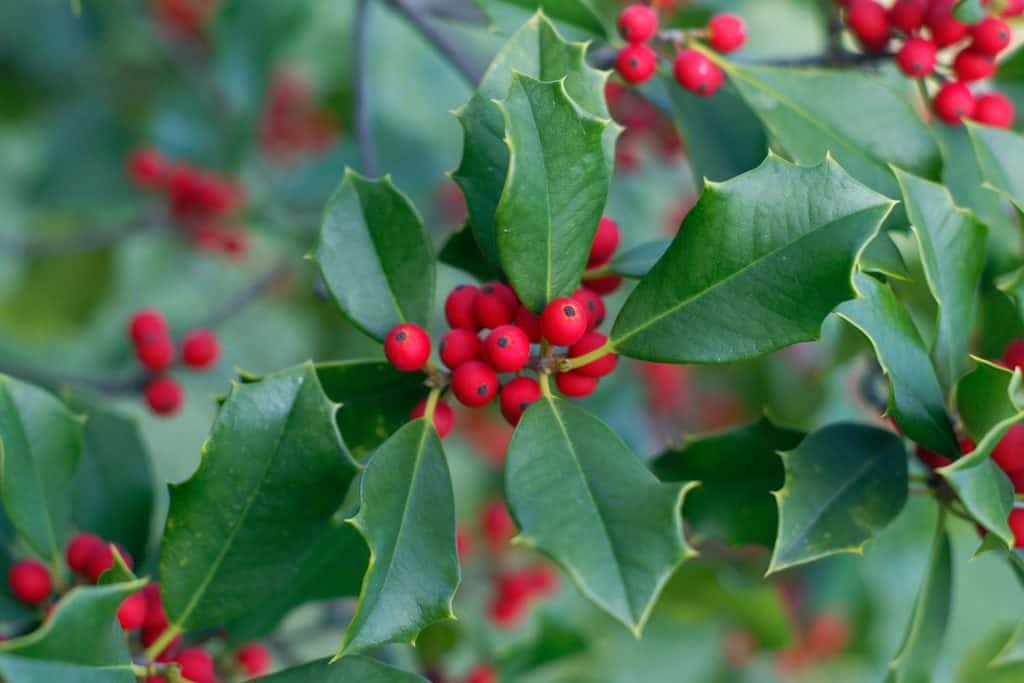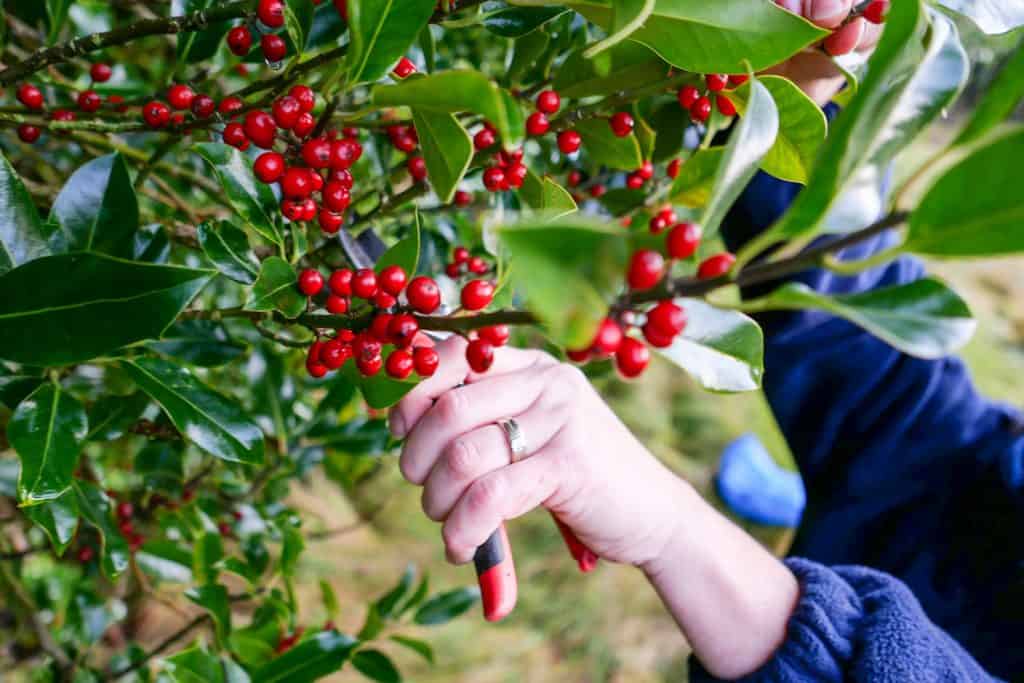You want to propagate some holly bushes or trees on your land by cutting a piece from an existing bush. You want to be sure you follow the correct procedure for the best outcome for your new holly plant. We have pulled together all the steps to cut, propagate, and plant holly on your property.
Holly cuttings can be made in winter, spring, or summer. To start a cutting:
- Cut off 6-inch pieces of new growth from the plant.
- Dip the cut ends of the plant into a rooting compound.
- Make a hole that is the same depth as the cutting.
- Place the cut end face down, fill in the hole with dirt, and tamp.
You know the basic requirements to propagate holly from cuttings. Now you need some more information to feel confident in your process. You probably wonder about the differences between deciduous and evergreen holly species. What kind of rooting compound is the best to purchase or if it is possible to make your own? You might also wonder about the best time to make holly cuttings. This post will break down all of these questions and provide you with the answers you need.
![Red colored berries of a holly tree photographed on a sunny day, How To Grow Holly From Cuttings [Holly Propagation Guide]](https://gardentabs.com/wp-content/uploads/2021/07/How-To-Grow-Holly-From-Cuttings-Holly-Propagation-Guide-683x1024.png)
How To Grow Holly From Cuttings
6-inch cuttings of new growth on holly plants can be propagated to grow more holly. The cutting is dipped into a rooting compound and planted just deep enough so the stem does not stick out above the ground.
1. Cut 6-Inch Pieces of New Growth
Use some pruning shears or a sharp knife to cut 6-inch pieces of new growth. You can take soft or hardwood cuttings of the plant in winter, spring, or summer.
2. Dip The Cut Ends Into Rooting Compound
You can purchase a rooting compound powder or gel. Place the cut ends into the rooting compound. If using soft wood cuttings in late spring or summer, you may choose to carve away the green outer layer of the cut tip before dipping into the rooting compound.
3. Make A Hole The Same Depth As The Cutting
Use a shovel to make a hole that is 6-inches deep, the same length as your cuttings.
4. Place The Cut End Face Down
Put the cut end into the ground. Fill in the hole with dirt and tamp down. The stem should be just slightly above the surface of the ground or level with the dirt.
Evergreen Bundle
You may take several evergreen holly cuttings and bundle several together for best results. When taking cuttings from deciduous holly plants, it is best to plant each 6-inch cutting separately. Place the whole cutting or bundle into the hole without any stem sticking out of the ground. Then fill in the hole. There are some additional steps that should be made depending on what season you make the cut.

When Can You Take Holly Cuttings?
There are two different kinds of propagation that are made with cuttings from a plant. You can make the cut and begin propagation during the cold-weather dormancy in winter or early spring. This is called hard-wood cutting. Most holly propagation occurs by using this method. You will cut 6-inches of new growth from the most recent season.
The alternative is soft-wood cutting. These cuts are made after the dormancy season when the foliage has grown back. This will take place during spring or summer. When you take soft-wood cuttings, there are some extra steps to increase your success rate. After cutting 6-inch sections from the plant, you can carefully whittle off the green flesh at the base of the plant. You will also remove any buds that exist in this 1-2 inch section at the base of the cutting.
Check out this video that shows how to take a soft-wood cutting from a holly plant.
What Is The Best Time To Propogate Holly Cuttings?
Most holly propagation occurs with hardwood cuttings which can only be done during the dormant season. Hardwood cuttings are simpler in the process because you don't need to cut away any green flesh to get the best results. Softwood cuttings must occur during mid-spring to late summer.
Some additional things to keep in mind are the amount of light you will be able to provide for your cuttings. Your holly cuttings should receive light during propagation, but should not receive too much light. Plant cuttings can receive diffused or indirect sunlight or artificial light. We will give more details about light requirements later in this post.

What Kind Of Soil And How Much Water For Holly Cuttings?
You can use coarse sand or a mix of perlite and peat moss for your pots. Pour water to saturate the soil medium and allow water to drain out while you collect your holly cuttings. You want to use pots that are a minimum of 6 inches to accommodate your 6-inch cuttings.
For a permanent place in your yard, holly plants prefer well-drained soil that is moderately acidic. Water your holly plants daily for the first week in the ground followed by twice per week until the plant becomes established. Holly plants will do best with 2 inches of water per week during the growing season.
For more information about watering holly trees and shrubs, check out this post. How Much Water Does A Holly Tree Need?
Should I Use Fertilizer?
You should not use fertilizer for your holly cuttings, but you can fertilize your holly shrub or tree once per year after it becomes established. This will provide the necessary nutrients for your plant to thrive. You can check out this post to learn about fertilizers you can use on your established holly plants. 7 Of The Best Fertilizers For Holly Bushes [And How To Use It]
How Do You Encourage Roots To Grow From Cuttings?
You can encourage roots to grow by whittling away the outer green layer of softwood cuttings. Only carve away about 1-2 inches near the base of the cutting. Both hardwood and softwood cuttings can be further encouraged by dipping them into a rooting hormone. A rooting compound is not necessary to propagate holly cuttings, but it does improve the success rate.
There are different root compounds on the market that can help you propagate holly. These compounds may be powder or gel-based. They all work the same way and only require you to dip the base end of the cutting into the gel or powder.
HydroDynamics Clonex Rooting Gel (100 ml)
Click here to buy HydroDynamics Clonex Rooting Gel from Amazon.
How Do You Make Your Own Rooting Hormone?
There are multiple household ingredients that you may use as a rooting hormone. While a rooting hormone is not necessary to propagate holly, dipping your cuttings into just one of these ingredients can increase your success rate. If you have multiple ingredients, you may mix them together to increase the power of the rooting compound.
Here is a list of possible ingredients. Some of these ingredients should not be overused.
- Saliva - Spit in a cup or lick the end of the stem (if not poisonous)
- Apple Cider Vinegar - 5 drops in a half cup of water (more than this can be detrimental to root growth)
- Cinnamon - after dipping in water roll the base of the stem in cinnamon powder
- Aspirin - 1 pill of 325 mg to one gallon of water
- Honey - 1/2 tablespoon per cup of water
You can use one or all of these ingredients if you have them available. Be sure not to use too much apple cider vinegar, aspirin or honey. You can combine these three ingredients in water at the correct ratios to dip your cuttings into. After you do that you could dip them in saliva and cinnamon before planting.

Do Cuttings Need Light To Root?
Stem cuttings always need light in order to develop roots through photosynthesis. Root cuttings can be left in the dark until leaf formation starts to occur. Stem cuttings from holly or other plants should receive artificial light or diffused sunlight. You can get diffused sunlight by keeping your cuttings near windows, but out of direct sunlight.
If you give the cuttings too much light or any amount of direct sunlight, they will be too stressed to form roots. Too much light also leads to dehydration. You want to make sure your cuttings are getting 8-12 hours of indirect sunlight or ambient artificial light throughout the day. After root development begins, you can increase the exposure up to 18 hours.
In Closing
Holly plants can be cut and propagated to create more bushes or trees for your landscape. No rooting compound is needed for this process, but using a compound will increase your success rate. There are several helpful ingredients you may already have in your kitchen pantry. You might use cinnamon, apple cider vinegar, honey, saliva, or crushed aspirin dissolved in water. After you cut 6-inch segments of new growth from the plant, you can dip the base into the rooting solution before planting.

